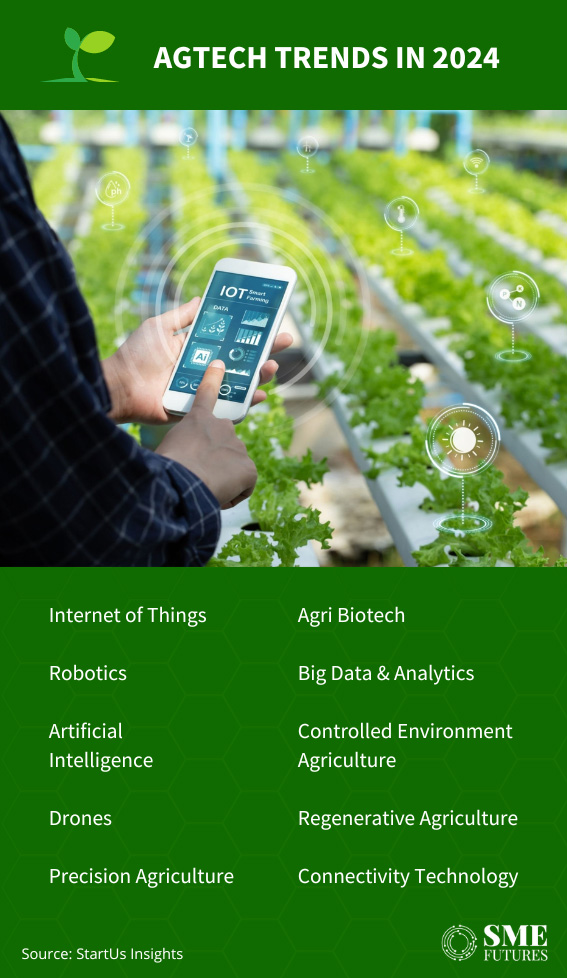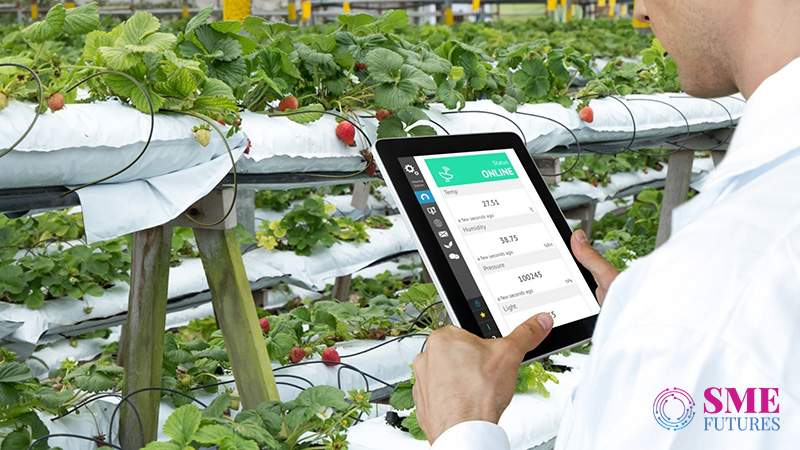The agricultural landscape in India is poised for significant growth with projections indicating a potential contribution of $600 billion to the country’s GDP by 2030, a 50 per cent increase from its 2020 contribution. This surge is particularly noteworthy given agriculture’s already substantial role, contributing over 18.3 per cent to the country’s Gross Value Added (GVA) and standing as the largest employment provider.
Furthermore, the country’s agricultural exports touched all-time highs of $50.2 bn in the year 2021-20 and $53.2 in 2022-23. The current global economic crisis has emphasised the significance of agriculture. Governments and investors worldwide are turning their attention to the sector, recognizing its potential to drive economic recovery.
As much as this space is a hotbed of opportunities, it is also marred with numerous challenges, including high-interest rates, soaring input costs, labour shortages, and the looming spectre of climate change. Farmers worldwide are seeking innovative ways to boost production, safeguard profits, and ensure environmental sustainability. This will be driving the trends in the agriculture sector in 2024.
Growing number of agtechs in India
In recent years, there has been a surge in the emergence of agtech firms, as new-age start-ups started disrupting the traditional agricultural sector with innovative ideas and cost-effective solutions.
As per a McKinsey analysis, between 2013 and 2020, the agtech landscape in India grew from less than 50 start-ups to more than 1,000. Tracxn data says that there are 3,056 agtech start-ups. However, these numbers are ever evolving, fuelled by increased farmer awareness, rising internet penetration in rural India, and the need for greater efficiency in the agriculture sector. Moreover, India’s regulatory environment is gradually evolving to facilitate the growth of digital technologies in agriculture.
Shashank Singh, Co-Founder of Poshn feels that so far, India has seen a steep hike in the number of start-ups emerging in this sector, all attempting to solve the numerous challenges that plague it.
“Supply-chain solutions, tech and innovation, lending etc., are some of the sub-sectors for these start-ups. These start-ups garnered unparalleled amounts of investments in between the years 2021-23. This reflects a strategic shift in priorities. As the world seeks to enhance food security and mitigate the impacts of economic downturns, the agriculture sector has become a focal point for sustainable growth,” he says.
Digital agriculture
Another major trend is the adoption of agtech solutions built on the back of AI/ML, IoT, open databases and cloud technology.
Harshal Sonawane, Head of Sustainability at nurture.farm, envisions a transformative landscape for the agritech industry in 2024.
“Precision agriculture trends like IoT devices, automated mechanisation, robotics, and drip irrigation technologies are set to drive efficiency and sustainability. Artificial intelligence (AI) is positioned as a cornerstone, revolutionising farming operations from predictive analytics to preventive insights. This automation extends to banking and insurance services for farmers,” he asserts.
The seamless fusion of digital farming and sustainable agriculture practices is expected to lead to a profitable, resilient, and sustainable future. Geotagging, satellite imaging, and monitoring of farm operations will provide traceable data sets, measurable impacts on greenhouse gas emissions, and transformative changes in cultivation practices, he adds.
The transition towards climate-smart techniques, bio-solutions, genetically modified seeds, farm automation, and soil health improvement will impact yield and profitability in the long run.

Investment scenario has changed dramatically
In recent years, agricultural technology in India has experienced significant growth, driven by the escalating interest of venture capital (VC).
According to an analysis by IBEF, Indian agtech companies have successfully raised a total of US$ 1.6 billion over the past four years. In 2022 alone, VC firms invested over US$ 1.2 billion in 114 acquisitions, marking a 50 per cent surge compared to 2021 and a threefold increase from the investments made in 2020.
Despite a two-year economic downturn, the escalating average deal size indicates the maturation of start-ups in this sector. Notably, in 2022, five agtech sectors garnered 90 per cent of the total VC funding, underlining the robust support for innovation within specific niches.
However, there is a paradigm shift in the investment trends for food and agtech start-ups.
According to a recent study by AgFunder, in 2023, downstream food delivery and restaurant start-ups, once the darling of the region’s agri foodtech ecosystem, fuelling tens of billions of dollars in investment, are no longer so attractive to investors.
The new star of the ecosystem is upstream innovation.
Upstream funding, supporting technologies for farmers and primary food producers, surpassed downstream investment for the first time, with $3.2 billion in 2022 compared to $2.7 million for the latter.
Sudhanshu Rai, Co-founder at Fyllo says that the shift in focus from downstream (market linkages) towards upstream (growing side, climate tech) will continue. “Downstream businesses bring huge GMV in a shorter period but are a very low margin business and face huge competition from local players that makes it difficult to scale sustainably. Companies that have raised funds are either pivoting or going down,” he contends.
Biotech also pivoted
The Asia-Pacific region saw substantial funding of around $813 million in agri biotechnology in 2022. Innovative food, encompassing the alternative protein industry, defied the global decline in funding and garnered $527 million. Farm management software, sensing & IoT, farm robotics, and novel farming systems start-ups secured more funding across fewer deals.
China temporarily lost its lead to India in 2022, but by H1 2023, reclaimed the top spot, raising $861 million.
Rai feels that the focus on upstream will increase as climate change is impacting agriculture a lot. for that matter, cotton production has reduced this year in North India due to an untimely attack of pink ball worm.
“Similarly, the varieties which have been resulting in better yield are now prone to diseases and pests and are fetching poor yield and quality. So, a large amount of innovation is needed and hence investment will flow here. Also, these are good margin businesses and can go global easily, while the strong distribution network for agri-input products in India will help to make scaling faster,” he says.
According to him, companies will be focusing on increasing production and bringing certainty to farm income by practising climate resilient or precision agriculture.
Biotech companies will build a better variety of seeds and bio-fertilisers. Aggregators who are bringing better variety in fruits with focus/partnerships on upstream will be the differentiators. FPOs are going to be in demand as companies will target them to test their ‘The whole product’ models. Sustainable packaging companies using agricultural waste as input will also thrive.
Currently, the Indian agriculture sector stands at the crossroads of innovation and sustainability, poised to redefine the agritech landscape and play a pivotal role in the economic revival of the nation. By maintaining a good balance between traditional expertise and the latest innovations, this sector will navigate through challenges and play a pivotal role in leading the economic revival in the country in 2024.











